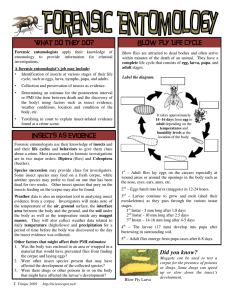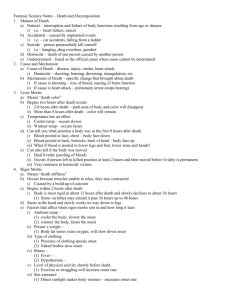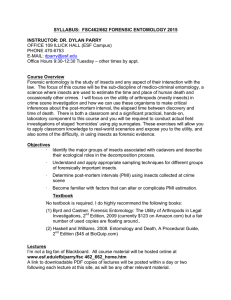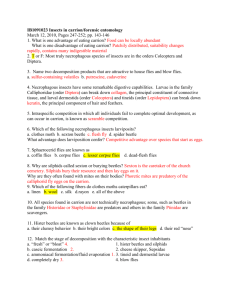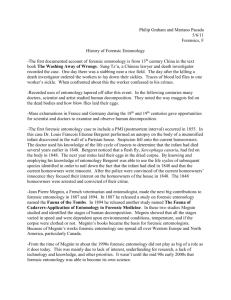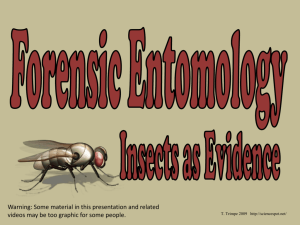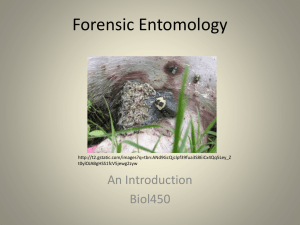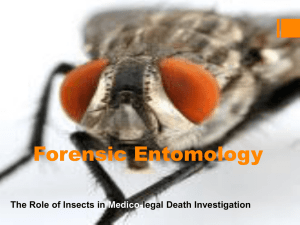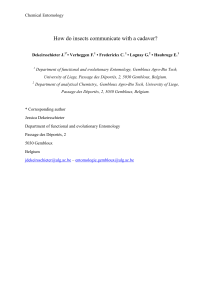Forensic Entomology
advertisement
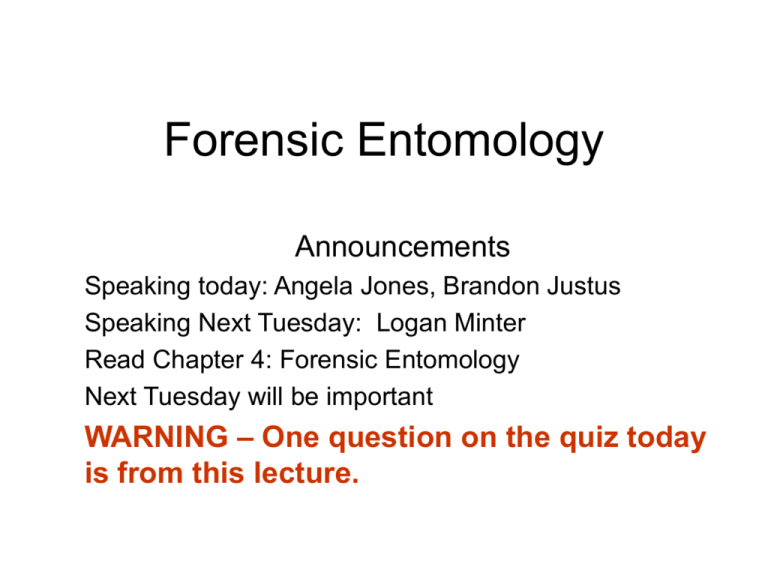
Forensic Entomology Announcements Speaking today: Angela Jones, Brandon Justus Speaking Next Tuesday: Logan Minter Read Chapter 4: Forensic Entomology Next Tuesday will be important WARNING – One question on the quiz today is from this lecture. Forensic Entomology • Defined: The use of the insects, and their arthropod relatives that inhabit decomposing remains to aid legal investigations. • 3 Broad Categories: – Medico-legal - criminal component of the legal system and deals with the necrophagous (or carrion) feeding insects that typically infest human remains. – Urban - both criminal and civil components as urban pests may feed on both the living and the dead. – Stored Products – Civil & criminal cases involving food contamination Types of forensic cases (not exclusive, not always medical) • Homicides (location, time, cause) • Abuse/Neglect of – Human (children/elderly) – Animal • Establish Chain of Control, transportation history • Cause/location/details of Accidents • Negligence – Storage/transport/distribution of items – Use of toxicants/chemicals/contaminants • Civil Duty of Care – Malpractice – Occupational Hazards – Trespass Most cases deal with human corpses • Interaction between – Time that the corpse is available to insects – Insect species in the area & their activity – Temperature & other environmental variables • Some insect species find corpses faster than do others, some are better colonizers at different stages of corpse decay. – Stage of decomposition – Insect community (species and age distribution) Decomposition of Human Corpses 1. Autolysis (Fresh) – – Cells autolyse aseptically Internal bacteria act anaerobically 2. Putrefaction (Bloating) – Lower abdomen bloats, turns green 3. Butyric fermentation (Black putrefaction) – – Body cavity ruptures, body darkens Mumification & adipocere formation occurs at this stage 4. Dry Decay (Skeletonization) – Slow deterioration of skeletal remains Fresh • Rigor mortis followed by algor mortis sets in within 72 hours. • Calliphorid flies (esp. green bottle flies ) are the first to arrive & lay eggs. • Hairy maggot blowflies (another calliphorid) are usually the second to arrive Green Bottle Fly Hairy Maggot Blowfly Putrefaction • Begins 4 – 10 days after death • Blowfly eggs have hatched, maggots are in orifices • Histerid beetles appear under body (if on land) Hister quadrinotatus Butyric Formation • 10 – 25 days after death • Maggots have begun to leave body, pupate in soil • Carrion Beetles & Skin Beetles become the dominant necrophage. About 15 days post mortem. Note the saponification or adipocere formation on the shoulder and arm. Nicrophorus vespillo Dry Decay • Begins 25 – 50 days after death, can last years. • Only dry skin, hair, bones remain • Fungus beetles, mites, clothes moths are most common. Normal soil fauna begins to inhabit the body. Factors Affecting Decomposition • Temperature/humidity – Lower temps slow down microbes & insects – Low humidity dries corpse, mummifies • Access – Submerged vs. on land – In open vs. interred vs. in shade • Reduction & Cause of Death – Large wounds lead to faster decomposition – Scavangers/vertebrate predators important too • Coverings & Pesticides – Tightly wrapped bodies decompose slower – Heavy clothing slows decomposition more than thinner clothing • Percent of body fat in corpse – More fat (higher water content, better heat retention) means faster decomposition • Drugs & chemicals – Insects on coke or meth burn through a body faster, bodies with arsenic decompose slower. Temperature Especially Important • Can be used to determine Post Mortem Interval – PMI = Time since death (Actually, time since initial colonization). – Most entomologically useful range is 2 – 4 weeks • Requires site-specific temperatures – Often a statistical correlation between the site and the nearest ambient temperatures – Statistical correlation produces a PMI range. PMI Calculation Example. Body is found with Lucilia sericata larvae, prepupae, and pupae (in soil next to body). Temps at site had averaged 16° C. Pupae brought into the lab & held at that temp. began to eclose after 112 hours Development rate of sheep blowflies, Lucilia sericata, (in hours) at three different temperatures Temp(°C) Egg Larva 1st Instar Larva 2nd Instar Larva 3rd Instar Prepupa Pupa Total time (days) 16 41 53 42 98 148 393 32 21 21 31 26 50 118 240 20 27 18 20 12 40 90 168 14 PMI = (41 + 53 + 42 + 98 + 148 + 393 – 112)/24 = 26.5 days Field continues to develop • Molecular techniques are increasingly important • Area is now a recognized board certification category – Certified by the American Board of Forensic Entomology – Very small group, may expand into other areas

